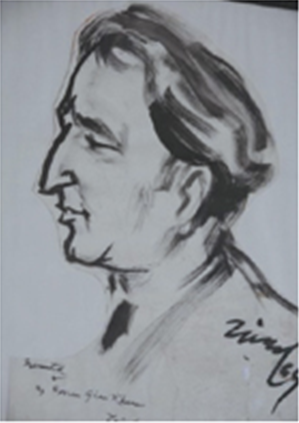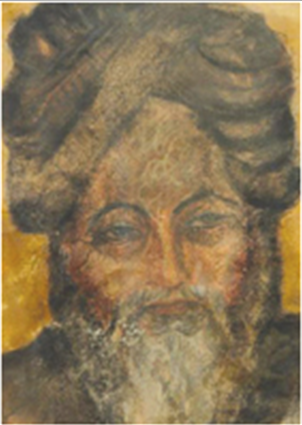Ghani Khan
This is a collection of articles archived for the excellence of their content. Readers will be able to edit existing articles and post new articles directly |
Ghani Khan
IN MEMORIAM: A master of lines
By Sher Alam Shinwari
March 15 marked the 12th death anniversary of Ghani Khan
Ghani Khan (1915-1996) eldest son of the legendry Pakhtoon leader, Baacha Khan was a widely acclaimed poet, painter, sculptor and a fine prose writer. Author of several books in Pashto, Urdu and English, he is known more for his writings than his art.
Khan was quite familiar with, and sensitive to, the cultural heritage and social values of his people, the Pakhtoons, and this is apparent in all his works. But it was his fine lines and masterly control over his brush that lends common everyday happenings a genuine feel.
Overgrown with wild bushes and variety of flowers Khan’s magnificent home ‘Darul Amaan’ near Charasadda bazaar gives one a real feel of a glorious life that had once the soul of this great artist and poet.
Khan began his art modestly by drawing pencil figures of his friends and relatives in early boyhood. During his stay at the Art School at Shantiniketan’s Visva Bharati University, near Calcutta, in 1934 he took to the study of sculpture and painting under Ram Kinkar and Nandalal Bose.
Of his time in Shantiniketan, he once said, “It was in the Shantiniketan that I discovered myself and the past greatness of my own culture and civilisation which has produced several men of versatile genius. It was a whole new experience for me. In Shantiniketan, I got the opportunity to assimilate Asian philosophy, literature, and appreciate performing and visual arts.”
Unfortunately for him, when his father Bacha Khan visited Shantiniketan in 1941 he did not approve of what his son was up to. Seeing the liberal, co-educational atmosphere and the pre-occupation of his son with sculpture and painting activities which, he did not at all consider to be of any practical use in the ongoing struggle against the British rule, he decided to withdraw him in mid-course from the institution. In an interview Khan once said, “My father considered painting and sculpture wastage of time, only my poems and national songs could make sense to him.”
Mahatma Gandhi’s intercession with Bacha Khan, at the insistence of Nandalal Bose, to allow him to complete his studies proved in fructuous. Ghani’s withdrawal in October 1934 was considered a great loss to the world of Indian art as, even during the short period that he was at Shantiniketan, Khan had provided ample evidence of his exceptional talent.
At the beginning in Shantiniketan, he was very impatient and was inclined to work in wood but his teachers advised him to continue with sculpture and painting. He was very much fascinated with human faces. “I want to get the personality of the person onto the paper and it could be done only by lines of one’s eyes and face.” He learnt painting from Nandalal Bose while Rabindra Nath Tagore taught him sculpture. Khan seemed to be more interested in sculptures than two-dimensional media but he equally exhibited his talent in paintings as well.
His short stay at Shantiniketan left an everlasting impact on his mind and artistic career. Khan painted in oils, watercolours and pastels. He loved to draw grim faces, intermixing strokes of several colours to make explicit its contours and bones. Art critics say Khan’s work on human faces had a striking resemblance in range, splendour, expression and variety with those of Spanish artist Francisco Jose Goya-Luccientcs (1746-1828).
Khan extensively studied Western and Greek philosophies and was much impressed by 19th century impressionistic movement. He was of the view that painting human feelings was the most difficult task, face he said being most important part of human body could very well reflect all of a person’s sentiments. About abstract impressionism he said, “Open your eyes and observe a thing deeply, then shut your eyes, think about that thing for sometime, it might have left an effect on your mind, this is impressionism but when you put that impression on a piece of paper or paint it on a canvas, this will be expressionism.”
He was great admirer of Michaelanglo and Rodin. His earlier sculptures in traditional academic style unlike his paintings are more realistic in approach, capturing the lines of his models. He was the true master of lines and colours. He did portraits in mixed media on gauche and crayons ignoring the shoulders and neck. The texture gives them a dramatic feeling and sense of deep impression.
Painting human behaviours and facial expressions of human beings with heads not in proportion to faces was Khan’s specialty. The strong features and lively strokes of the pastels and charcoal still keep intact the attention of the audience.
A restless artist, Khan had a multidimensional personality. He would sit down to write a poem but leave in the middle to paint and if dissatisfied with that, he would write prose. He was a generous artist and after squeezing out personal satisfaction he would gift his work to friends and relatives.
Around 200 of his art pieces remain at his home Darul Amaan. Mashaal Khan his grandson is worried about their proper maintenance and preservation. “I had put some of the paintings into frames three years ago but they need to be taken care of by a professional.” He did not give the art work to the newly established Ghani Khan Derai on Takhtbhai Road because he was not sure of its proper placement and due care.
In his lifetime, Khan had only two solo exhibitions, one each at Abaseen Arts Council, Peshawar (AACP) in 1970 and another in Lahore under the auspices of Saba Hussain Qizilbash in 1993. Most of his sculptures are done in clay and wood while for portraits he used mixed media. Mashaal Khan wishes to set up a Ghani Khan Trust (GKT) to preserve art pieces of his legendary grandfather.
Ghani Khan did portraits in mixed media on gauche and crayons ignoring the shoulders and neck. The texture gives them a dramatic feeling and sense of deep impression.






